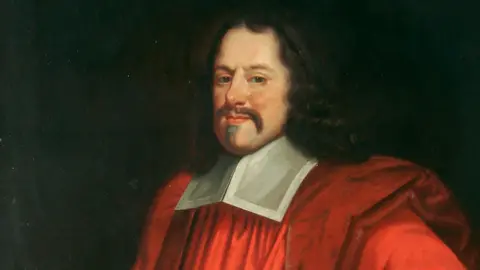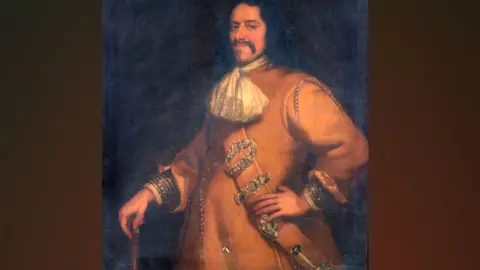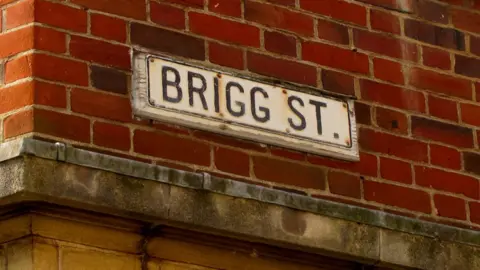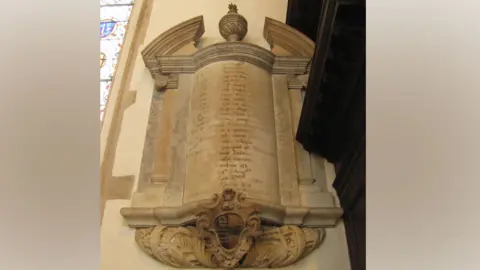Norwich grocer's story mirrors 17th Century highs and lows
 Norwich Castle Museum
Norwich Castle MuseumThe story of a grocer whose life mirrored the highs and lows of the English Civil War era has been uncovered by a coin expert.
Former Norwich mayor Augustine Briggs is remembered in a city street name, yet "most people don't have a clue why it's called that", said Adrian Marsden.
He survived a failed Royalist siege and lived to lead the city's persecution of Quakers, before dying a wealthy man.
Dr Marsden researched his life as part of the Norfolk Token Project.
"Many cavaliers expend everything in the king's cause, are ruined and they don't come back from that when Charles II is restored," he said.
"Briggs is fortunate to come out on the winning side - and be in a position to take advantage of that."
 Norfolk Token Project
Norfolk Token ProjectTrading tokens were a type of coinage issued by merchants in the mid-17th Century to enable trading activities amid a shortage of officially-issued coins.
Dr Marsden is investigating the people behind them, which include Mr Briggs.
Born in about 1617, Mr Briggs was the younger son of a landowner and sent to Norwich to take up an apprenticeship as a grocer.
He was on the Royalist side during the Civil War at King's Lynn when it declared for Charles I in 1643. It surrendered to Parliament after a gruelling three week siege.
Dr Marsden said when Mr Briggs returned to Norwich he "kept his head down" and concentrated on building his trade.
 Norwich Castle Museum
Norwich Castle MuseumDr Marsden said: "With the Restoration he comes into his own, becoming an alderman and it's quite possible he is being very loud about earlier Royalist involvement.
"There's a story he wore a sword he claimed to have 'carried for the sainted martyr King Charles I' in the siege of King's Lynn.
"And the new regime has probably got a fairly small pond to choose from as a lot of people in East Anglia were ardent for the Commonwealth, so the powers that be have to find someone they can trust."
Aldermen were high-ranking officials who needed to be wealthy because they were expected to contribute towards civic functions and donate to the poor.
The royal administration would have been keen to have loyalists in authority in Norwich, then considered England's second most important city.
 Adrian Marsden
Adrian MarsdenMr Briggs' career took off and he became a burgess, representing Norwich in Parliament, and city mayor.
But he also led the persecution of members of the Society of Friends, better known as the Quakers, in Norfolk.
The newly-formed sect was seen as a hotbed of dangerous heretics and in 1680, 10,000 Quakers were imprisoned and nearly 250 died.
Dr Marsden said: "He was a JP (justice of the pace) and between 50 to 60 Quakers are rounded up on Norwich and brought before him by two sheriffs, one of whom is punching them in the back.
"They ask for decent accommodation - but Briggs puts them in the hole, a medieval cellar adapted as a prison under the Guildhall which was declared unfit for people in the Elizabethan period."
Two years later, "16 hardcore members are still there".
 Norfolk Token Project
Norfolk Token Project Norfolk Token Project
Norfolk Token ProjectMr Briggs died in 1684, leaving considerable sums of money to his family and for the creation of two orphanages.
The road he lived on was immediately called Briggs Lane and today it is called Brigg Street after the road was renamed in the 1820s and the "s" dropped.
Dr Marsden said: "He was very much a man of his time and I think it a shame his story has been forgotten.
"It's good to walk around Norwich and know there are still reminders of him."

Follow East of England news on Facebook, Instagram and X. Got a story? Email [email protected] or WhatsApp 0800 169 183
